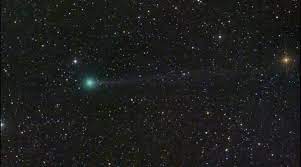Comet Nishimura:

NASA said that it seems like a good bet that Comet Nishimura could become visible to the naked eye this week
- Comet Nishimura was discovered in mid-August by amateur astronaut Hideo Nishimura, who used 30-second exposures with a standard digital camera to see it.
- Since then, the comet, officially called C/2023 P1 Nishimura, has increased in brightness as it went forward on its path in the inner solar system.
- The comet is angularly near the Sun, so even if it is visible, it will only be able to spot it early before sunrise or late before sunset.
- The comet is currently located in the constellation Leo.
- It completes an orbit around the Sun once every 435 years.
- Comets are cosmic snowballs of frozen gases, rock and dust that orbit the Sun.
- They are leftovers from the formation of the solar system.
- Typically, they range from a few kilometres to tens of kilometres wide. But as they orbit closer to the Sun, they spew out gases and dust, which form the tails that they are famous for.




